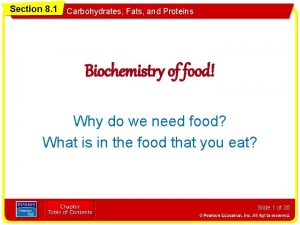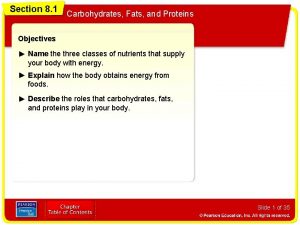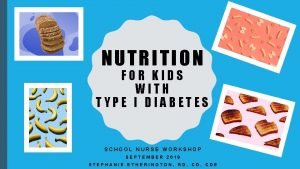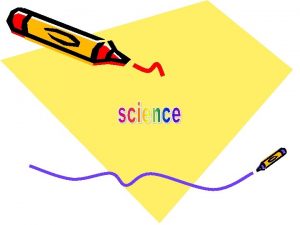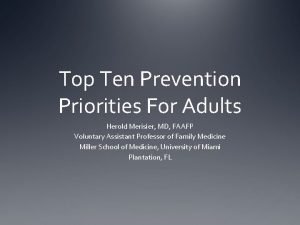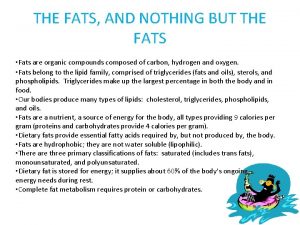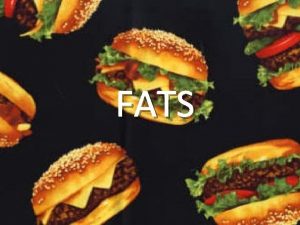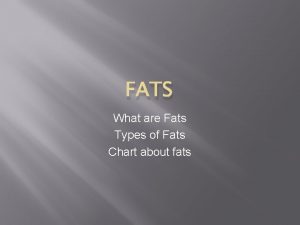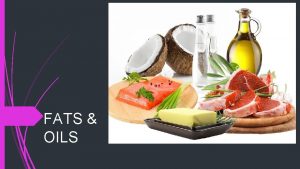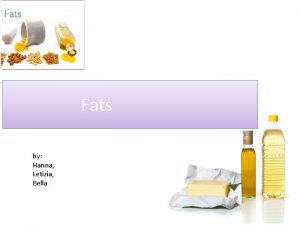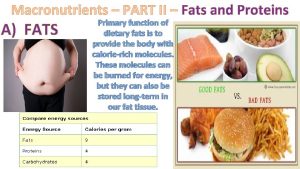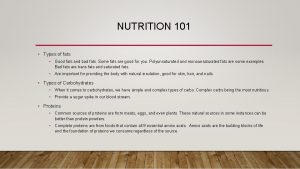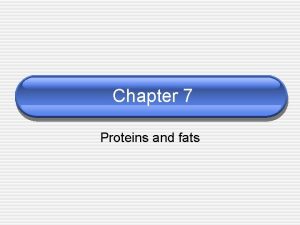Fats and Proteins Unit 4 Nutrition Fats Recommended










- Slides: 10

Fats and Proteins Unit 4 Nutrition

Fats • Recommended 20 to 35 percent come from fat. • The good: supply body with energy, form cells, and maintain body temp. • The bad: Has twice as many calories as carbohydrates per gram, cause heart disease, and weight gain.

• Unsaturated (most are liquid at room temp. ) – Vegetable oils, nuts, and seeds – Monounsaturated (olive oil, peanuts and canola oil) and polyunsaturated (corn and soybean oil) – Easily broken down – Can help fight heart disease

• Saturated (most are solid at room temp. ) – Meat, whole milk, butter, ice cream. – Cause weight gain, increased blood cholesterol levels and risk of heart disease.

• Cholesterol (found in animal products) – Liver makes it, so not necessary – Meat, egg yoke, fish and poultry – Too much of cholesterol and fat = plaque build-up and heart attack – LDL and HDL

• Trans Fats (Made when hydrogen is added to fat in vegetable oils) – Stay fresh longer than unsaturated fats. – Margarine, chips, french fries, doughnuts and cookies. – Few of the benefits of unsaturated and many of risks of saturated. – Raise LDL (bad) and lower HDL (good).

Protein • Can serve as source of energy • Growth and Repair of body tissues. • Amino acid chains form protein. – Body breaks down into amino acid – 20 different types (9 essential amino acids and 11 nonessential amino acids) • Ex: meats, eggs, poultry, milk, nuts, dried beans and dried peas.

• 9 essential amino acids can’t be made by the body. • 11 nonessential amino acids can be made by the body. • Complete proteins – Contain all 9 essential amino acids. – Meat and fish. • Incomplete proteins – Don’t contain the 9 essential amino acids. – Plants, grains, beans and vegetables.

Thinking about it all… • Carbohydrates – 45 to 65 percent of daily caloric intake • Fats – 20 to 35 percent of daily caloric intake • Protein – 10 to 35 percent of daily caloric intake

Activity Time Create a brochure describing 3 benefits of each (carb’s, fats and proteins) and draw 1 food that each nutrient is found in. Create a cover for your brochure and three panels. Include color and creativity.
 Section 8-1 carbohydrates fats and proteins answer key
Section 8-1 carbohydrates fats and proteins answer key Section 8-1 summary carbohydrates fats and proteins
Section 8-1 summary carbohydrates fats and proteins Carbohydrates, proteins and fats chart pdf
Carbohydrates, proteins and fats chart pdf Food pyramid carbohydrates fats proteins vitamins minerals
Food pyramid carbohydrates fats proteins vitamins minerals Explain when rtv and anaerobic sealers are recommended.
Explain when rtv and anaerobic sealers are recommended. Recommended alcohol intake per day
Recommended alcohol intake per day Past subjunctive mood examples
Past subjunctive mood examples Ticket revalidation/reissue is recommended
Ticket revalidation/reissue is recommended Accenture delivery suite(ads) support
Accenture delivery suite(ads) support Education without burden
Education without burden Trip advisor namibia
Trip advisor namibia
